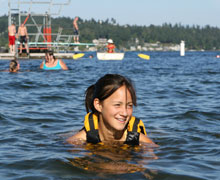Water Safety for Teens 12 to 18 Years Old
You can download this article as a PDF (English) (Spanish).
 As your child becomes a teen, you will likely have less control over their actions in and around water. Teens are much more likely to swim in open water without lifeguards, like lakes, rivers and the ocean. Peer pressure may cause your teen to try risky new activities they might not be ready for.
As your child becomes a teen, you will likely have less control over their actions in and around water. Teens are much more likely to swim in open water without lifeguards, like lakes, rivers and the ocean. Peer pressure may cause your teen to try risky new activities they might not be ready for.
While you may no longer always be there with them, your role is still important for their safety. Continue to set firm rules and expectations for your teen’s safety while in and around water. Support your teen by helping them to be water smart and have skills in the water.
Teach your teen to be water smart
- Judge their swimming ability. Teens often drown while trying to swim across a lake or river. They need to know that distances over water are hard to judge. Cold water and currents can overpower the skills of even a good swimmer or athlete, and can take away their strength before they know it.
- Before they dive, swing or jump into water, check it out for depth and any hazards or objects that can’t be seen from the surface. Teens are more likely than any other age group to suffer diving injuries, many of which result in spinal cord damage or death.
- Water play is no joke. Get help for others if in doubt. Teens most often drown when they are with friends. Teens have died because their friends didn’t know they were in trouble or thought they were joking and then did not know how to respond.
- Water and alcohol don’t mix. Nearly half of all drownings in teen males are tied to alcohol use. Alcohol affects judgment and swimming skills. It also increases the effects of hypothermia.
- Boat or swim in a life jacket when in an area with no lifeguards. Besides, life jackets make floating and swimming easier and fun for a longer time.
- Be aware of the dangers of cold water and currents. Swimming in open water is not like swimming in a pool.
Take action
Know your teen’s limits.
- If your teen is not a strong swimmer, sign them up for lessons. Knowing how to float, tread water and swim to safety are critical survival skills. Ask about teen-only swim lessons or options for taking adult lessons.
- Know where your teen is going and have a system for checking in. Tell them it’s important to swim in areas with lifeguards and to use the buddy system.
- Practice problem-solving with your teen. “It is a warm April night and your buddies want to go swimming at a local beach; you don’t feel OK going along. What can you do?”
Know the water
- Washington state’s lakes and rivers are cold enough to cause drowning by cold water shock, even in the summer and even among the strongest swimmers. A person in cold water can automatically inhale and pull water into their lungs. This causes them to choke and panic. Death can occur in minutes. Hypothermia is another risk. It occurs when the body temperature lowers. This leads to a loss of the strength that is needed to swim. A life jacket can reduce heat loss, keep you afloat and more than double survival time.
- Talk with your teen about diving into shallow or unknown water. The first entry into any water should be feet first. Teach them to only dive in water that is at least nine feet deep.
- Spend time as a family talking about how to stay safe by identifying risks like cold water, high water, river and rip currents. Check into local recreation and outdoor programs that teach outdoor water safety.
Get your teen a life jacket
- Pick out a life jacket with your teen. There are many comfortable and stylish models available, including inflatable life jackets. Have your teen wear it when boating or swimming in a lake or river that has no lifeguard.
- Be a role model while boating. Wear a life jacket yourself and don’t drink alcohol or use drugs. Teens are more likely to wear a life jacket if you do too.
Resources:
Information and resources for parents, kids, teens and educators.
- U.S. Coast Guard Office of Boating Safety
- Safe Boating Campaign
- Washington State Parks Boating Program, 360-902-8844
Washington state law requires boaters ages 12 and older to pass a boating safety course or an exam before driving a motor boat of 15 horsepower or greater. It is also state law that all people in a boat must have a properly fitting U.S. Coast Guard–approved life jacket.

